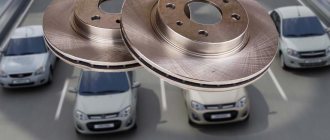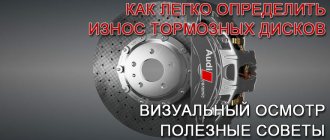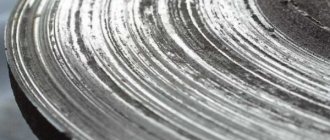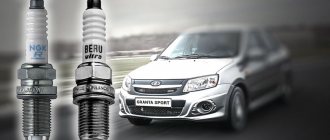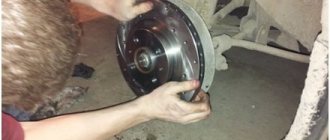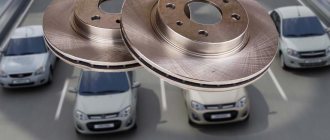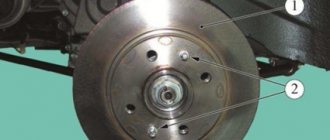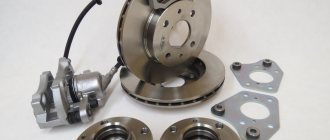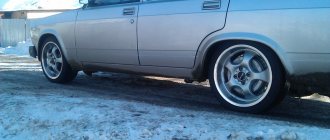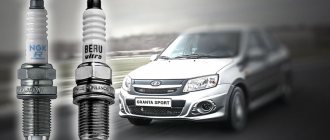The brake mechanisms of my car are worn out, don't play around with them. I thought about slowly changing the rear brakes, but after removing the front wheels I realized that the Khan discs have a ventilated disc thickness of 15.3 mm, with the minimum allowable being 17.8 mm. I’m not a racer, I ride on average 40-50 km a day. All wheels (summer and winter) are 13 inches and I don’t plan to switch to 14 wheels yet. So I choose brake discs of 13 radius, ventilated, but without perforation. So far I have found in the store: 1) Alnas - 680 rubles. 2) ATS - 750 rubles 3) VIS (Vazinterservice, AvtoVAZ) - the price is around the first two 4) LUCAS/TRW R13 VENT 4108 - but the price is 1320 rubles. 5) BRAKE DISCS AUTOREAL COMP 2PCS - 940r
I don’t know what to choose from the budget ones. And which pads are best suited to the selected discs (it’s easier with them, there is exist on the edge). What discs and pads do you recommend?
Depending on the configuration, the manufacturer equips Lada cars with different front brakes. We determine which brake discs AvtoVAZ installs on Priora, Granta and Kalina, what is the difference between the front brake mechanisms, and how to very easily improve the brakes without modifications.
Installation of brake pads and discs from a foreign car
Instead of original VAZ brake pads and brake discs, install consumables from a foreign car, for example:
- Brembo brake discs (article: 09.8903.75) or ATE Power Disc 14 (article: 24.0320-0142.1);
- pads from Fiat (article: 13.0460-2813.2) or BMW (article: 180281).
No modifications or design changes to the brake system are required. The maximum that may be required (for example, for pads from BMW) is to slightly file the caliper brackets.
How are these components better? The discs have an increased contact area of the pads, and the brake pads have an increased contact area (by about 25%). According to reviews from car enthusiasts, the installation of imported brake pads and discs had a positive effect on the performance of the braking system.
What kind of feedback can you leave about such a simple brake tuning? Is it worth switching from R13 to R14 brakes and abandoning original spare parts in favor of imported ones? Let us remind you that other useful tips for improving Lada cars can be found in the “Tuning” category. For example, you can significantly reduce noise in the cabin by installing additional door seals.
Serviceable brake discs of thickness specified by the manufacturer are the key to safety on the road. AvtoVAZ has equipped the Lada Granta with a reliable braking system. This allows you to reduce the likelihood of accidents and avoid emergencies on the road. But over time, the disc wears off and a bead appears on its surface. There is a need for replacement.
Rear pads for Grants
Front brake pads should be replaced when the linings have worn down to a minimum thickness of 2 mm, or have become unusable due to loss of their properties: the linings have peeled off, crumbled or become charred. On average, front pads last 15-30 thousand. km. mileage The service life of the rear clutches is on average three times greater than that of the front clutches.
In order to change the front pads on a Grant yourself, you will need:
- key to 13;
- key to 17;
- flat screwdriver;
- jack.
The procedure itself is quite simple. To replace the front pads you need:
- Raise the car using a jack and securely support it with jack stands.
- Remove the wheel and unscrew the steering wheel for easy access to the brake mechanism.
- Unscrew the lower bolt of the caliper using keys 13 and 17. First bend the corner of the fixing washer with a screwdriver.
- Remove the lower guide bolt and lift the caliper up. Before removing the pads, it is recommended to immediately press in the caliper piston using a screwdriver (pressing it between the inner pad and the disc).
- Carefully inspect the condition of the caliper itself, the guide boots and the working cylinder.
In case of extreme wear of the brake discs to a working surface thickness of 18 mm, it is better to replace the Lada Granta brake pads together with discs from the same manufacturer and, of course, a set for both front wheels at the same time.
https://www.youtube.com/watch?v=ytdevru
Examples of replacement kits:
- Disc brake pads TRW GDB469M ventilated brake disc TRW DF4107 ;
- Disc brake pads, set ATE 13.0460-2965.2 Ventilated brake disc ATE 24.0120-0187.1 ;
- Front disc brake pads, set Brembo P 41 003 Front ventilated brake disc Brembo 09.8903.14.
The procedure for replacing rear drum pads is a little more troublesome and will require some skill. You can learn more about the nuances using the example of the Lada Kalina car in the article.
Welcome! Brake discs are made of cast iron, in sports cars they are made of ceramics, but ordinary low-power cars simply do not need ceramic discs, there are plenty of cast iron discs, the main difference in these two brake discs is, of course, their price, then the specifications are already there and everything else, but the price of ceramic discs really makes you horrified (About 100-150 thousand.
one disc costs rubles), that’s why such discs are not installed on our domestic cars, let’s forget about ceramics and talk about cast iron, these discs come in different types, if you take the regular ones (the cheapest ones), then it will be just a bare disc without any special ones. dimples for cooling, such discs are very cheap, but their main disadvantage is that in hot weather during intense braking they heat up very much, and as many people know, the hotter the brake disc is, the worse the car will stop, besides these there are also perforated discs and ventilated, these are already more expensive wheels (they won’t cost too much, but it will be quite noticeable), but their main feature is that they will cool down when driving at speed and braking efficiency will not drop, as usually happens with bare (Without everything) brake discs.
Rear brake discs need to be replaced if you notice that the braking distance is increased, the vehicle pulls to the side when braking, the brake fluid level has decreased, the brake pedal has become soft, and also if they are worn to an acceptable minimum, deformed or damaged.
First of all, we tear off the front wheel mounting bolts, and then jack up the car. Then completely remove the wheel from the car. Next we will need a torx t12 socket to unscrew and remove the caliper. Then we hang it in such a way that there is no load on the hose.
Then, using a 7 key, unscrew the two guide pins that secure it to the hub.
After this, we apply penetrating lubricant on the reverse side, since, most likely, the disc is stuck to the hub.
After waiting a few minutes, you can begin to dismantle the disk, using either a special puller or a hammer and a wooden spacer.
After several attempts, most likely you will still be able to cope with this job.
Lada Granta rear brake pads with number 2108-3502090 are also equipped on VAZ 2110, Kalina, Priora and Samara cars that do not have an ABS system.
Rear brake pads on Grants with ABS are numbered 21920-3502090-10. For retail, product code 21920-3502090-55 is used.
They differ from the previous ones by the presence of a hole for the wheel rotation sensor. Identical components are used on VAZ 2110, second generation Kalina, Priora, Samara cars with an anti-lock brake system.
These clutches are supplied to the AvtoVAZ conveyor by JSC TIIR. The TIIR-444 composite overlay itself is marked with article number 2192-3502105. The improved composition of the linings is designed to increase the tenacity of the rear brakes especially for cars with ABS.
The products of the German company ATE enjoy the greatest popularity and positive reviews among analogues. These front pads under article number 13.0460-2965.2 work well in tandem with the original brake disc in all operating modes.
In second place in popularity and quality are Lucas/TRW products. Front brake pads with article number GDB 1446 have a built-in electronic wear sensor for vehicles in the Luxury configuration. Their price is slightly higher than that of TRW GDB 469 pads, which are also an analogue for replacement. It is important to note that there are lower quality TRW GDB 469M pads available for sale, produced at a factory in China using cheaper technology.
| Manufacturer | Catalog number | Average price as of 02/05/2018 |
| TSN | 2.1.4 | 320 rub. |
| Allied Nippon | ADB 0173 | 350 rub. |
| Fenox | BP40006O7 | 370 rub. |
| PILENGA | FD-P 2003 | 370 rub. |
| Finwhale | V 218 | 390 rub. |
| PILENGA | FD-P 2005 | 400 rub. |
| Sangsin | SP 1181 | 470 rub. |
| Valeo | 301 406 | 600 rub. |
| NiBK | PN-0223 | 600 rub |
What front brake discs should be installed on the Lada Granta
The front wheels of the Lada Granta are equipped with disc shoe brakes. What makes the pedal informative is that it makes it easy to calculate where to stop.
The power reserve with original parts can range from 50 to 120 thousand km. But sooner or later the need for replacement arises.
You can divide all supplied spare parts into two main categories: original and analogues. The former are more expensive. But at the same time, their maximum mileage is usually an order of magnitude greater than their analogues. There is multi-stage quality control in production. The downside is the high cost. Sometimes it is 2-3 times more than analogues.
You asked: What kind of brake discs are on the Kalina Cross?
Issue price: Front brake discs 2112 ventilated R14 (Euro-sport) (Almetyevsk) - 1900 rubles Front brake pads TRW GDB1446 - 680 rubles. Caliper brackets 2112 - 1200 rub. Total: 3780 rub.
Depending on the configuration, the manufacturer equips Lada cars with different front brakes. We determine which brake discs AvtoVAZ installs on Priora, Granta and Kalina, what is the difference between the front brake mechanisms, and how to very easily improve the brakes without modifications.
Aluminum brake drums
Now they are the most advanced. Why? Yes, they simply weigh little, and manufacturers are trying their best to lighten the weight of the car and, in particular, reduce the load on the axle.
Therefore, this material is now being used more and more often, what other advantages are there:
- As I already wrote, this is weight. Aluminum can weigh up to 50% less than the same cast iron version.
- Price. Not to say that they were cheaper just like that, after all, they are non-ferrous metal. But due to the mass, the difference in price is quite significant. About 30% cheaper.
- Cooling. This is really a big plus, we all know that during prolonged braking, say in the city, the discs and drums literally get hot. Aluminum conducts heat well, meaning it heats up quickly and cools down quickly. Therefore, drums made from it perfectly remove heat and cool quickly enough. Also, you can often see ribs on them, for even greater heat dissipation. It is worth noting that the more the drum heats up, the more effective the brakes decrease, and the pads simply begin to “float”. Cooling saves the situation and efficiency is maintained.
- Corrosion and aesthetic appearance. Yes, it should be noted that aluminum practically does not show any signs of rust or other decay. Thus, the outer and inner surfaces always remain clean. It is practical, and also aesthetically pleasing; there is no need to tint or maintain it. This is definitely a plus.
But this system also has disadvantages and they are also significant, let’s take it in order.
- The very first disadvantage is greater wear on the disc. Aluminum is a soft metal and therefore wears out quickly. You will change much more often than your opponent.
- They get very attached. This material sticks very strongly to the place of attachment, and it is not at all easy to remove them.
- Fragility. If you plan to remove them, then you must have special pullers, otherwise there is a high probability of breaking the drum, it is very fragile.
- With strong heating, after falling into a puddle, the geometry can change. What will affect the quality of braking?
To be honest, aluminum drums are not as durable a product as, say, cast iron. They really break very easily. Let’s say your rear wheel is stuck, the brake lining is torn off due to high wear, you won’t be able to just remove it and look inside, and if you hit it with a hammer, you’ll simply break the drum. In this regard, the opponent looks much more profitable.
So which is better?
What to choose in the end so as not to make a mistake? Guys, I’ll say that very few people now change aluminum to cast iron in drums or vice versa, most likely the replacement will be with disc brakes (they are really better), and ventilated or even perforated , it has been proven that with these the car brakes 15 - 20% more efficiently.
And the choice between these two, I personally would fall on cast iron, but it needs to be tinted, and it’s heavier, a pair is about 8-10 kilograms, but it’s more reliable and easier to remove. This is my personal opinion.
Did you like the article? Subscribe to the channel to stay up to date with the most interesting materials
Cast iron brake drums
Needless to say, this metal is much stronger, but also many times heavier than its opponent. Some manufacturers sacrifice suspension lightweighting and still install cast iron on their cars.
Original
The advantage is exact compliance with the specified dimensions. After purchasing the part, there is no need to adjust it to size or grind it down:
| Name | vendor code | Cost per 1 piece, rubles |
| AvtoVAZ | 11180-3501012-10 | From 2 thousand rubles |
Various manufacturers can be the manufacturer of original parts of this type for cars. But the products are labeled as AvtoVAZ. The quality is up to the mark. A special alloy of cast iron is used. It is allowed to use pads whose friction linings include ceramics.
Analogs
The selection of replacements for original parts includes several dozen items. The highest quality and relatively inexpensive are the following:
| Name | vendor code | Cost, per 1 piece, rubles |
| Alnas Sport, ventilated perforated | 2112-3501070-03 | From 1 thousand rubles |
| Notched, “PowerDisc”ATE | 24.0320-0142.1 | From 1.5 thousand rubles |
| BREMBO MAX | 09.8903.75 | From 1.2 thousand rubles |
What rear brake discs can be installed on the Lada Granta
Despite the fact that this car belongs to the budget class and is one of the cheapest among those sold in the Russian Federation, it is equipped with rear disc brakes. Which implies the need to replace individual components. The price of parts depends on their type, as well as other factors.
It is important to remember: the front and rear discs differ in the diameter of the mounting holes and other parameters. Installation can be done by yourself. The process itself is simple. But it requires some preparation. It is important to decide on a budget for parts in advance. All of them are divided into two main categories - analogues and originals. They differ in price and quality.
There are many types of discs. These are ventilated, with notches and various others. If the driver practices an aggressive driving style, then you should opt for ventilated models. They cool faster. They have more resources. The replacement process is no different from the others.
What affects brake disc wear?
In order to anticipate questions from motorists about what the acceptable wear of brake discs should or could be, I will answer this way. Each manufacturer has its own digital parameters for the maximum permissible wear of brake discs and pads.
There are corresponding tables for brands and models of the same brand (this also happens). This is primarily due to engine power, the weight of the car and the ensuing consequences in the form of physical forces acting on the car during braking.
Manufacturing materials.
First of all, the factory wear values of brake discs are affected by the material used to make the brake discs.
Traditional brake discs are made of cast iron, but modern technology has also made it possible to make discs from carbon fiber (carbon fiber) and ceramics. This is an objective factor. Next are subjective factors that influence the degree of wear of brake discs.
Mechanical factors: vehicle mileage, availability of high-quality brake pads. Poor quality brake pads lead to uneven wear of the brake disc and the appearance of “scoring” on it. In this case, repair of the brake system is required: grooving the brake disc before replacing the pads.
Vehicle operating conditions. To a greater extent, this is a factor that depends on the driver. For example, during winter operation it is quite possible to cause the brake disc to deform.
When driving, in any case, the disc heats up, and if you drive into a puddle of water, and the temperature outside is still low, then the sudden temperature change causes deformation of the brake disc.
And if this happens periodically, then you cannot avoid regrooving or replacing the brake disc.
Driving style. According to average statistical figures, a brake disc should last 100 - 150 thousand km. mileage But, some drivers already at 6-15 thousand km can safely go to a service station - complete wear of the disk as a result of the so-called. “Schumacher” style: acceleration, braking and the cycle repeats. Emergency braking is a direct path to rapid wear of the brake disc.
Analogs
The cost of original components is an order of magnitude higher than analogues. Therefore, the choice of many vehicle owners falls on substitutes. The most advantageous offers:
| Name | vendor code | Cost, rubles |
| A.S.P. | 2702220 | 2 thousand rubles. for 1 piece |
| B.M. | BDV 885 | 1 thousand rubles for 1 piece. |
| Hella | 8DD355109331 | 1.6 thousand rubles for 1 piece. |
Replacing front brake discs
The replacement algorithm includes the main steps:
- it is necessary to remove the wheel and jack up the car;
- the old brake pads are removed - to do this, the guide bolts are unscrewed and the caliper is folded back;
- The bracket is carefully hung on the suspension, after which you can begin to remove the disk - two nuts are unscrewed;
- if for some reason the disk cannot be removed from the bolts, you need to lightly hit it with a hammer from the reverse side;
- The new disk is carefully installed.
The nuts are screwed into place. It is advisable to pre-lubricate the threads with graphite lubricant. This will prevent souring. It is advisable to change the pads along with the discs.
Granta 41 2 new size
If, as a result of wear, a high shoulder has formed on the maximum diameter of the disk, which prevents an accurate measurement, remove the shoulder using a file or other method, or measure the thickness of the disk with a micrometer. We replace a brake disc with defects in the working surfaces or extreme wear.
The degree of wear of the brake pads of the rear wheel is assessed by the condition of the front pad, which wears out faster than the rear one.
What size brake discs are on Grant 13 or 14
Good evening everyone
by Adminrive · Published 01/07/2015
In America, when you stop at a gas station, your gasoline may be pumped out and missed
by Adminrive · Published 08/21/2013
Replacing rear brake discs
The algorithm for replacing rear brake discs is as simple as the front ones. The process is similar. Its main stages:
- it is necessary to remove the wheel to gain access directly to the part - the car is raised on a jack or lift;
- the caliper is removed along with the pads - you can place it side by side or hang it on a spring;
- use an open-end wrench to unscrew two nuts;
- a new disk is installed.
Assembling the caliper, installing the pads - everything is done in the reverse order. It is necessary to ensure that the thickness of the brake disc corresponds to that specified by the manufacturer. If you have difficulty removing the pads, you need to press in the cylinder with a screwdriver. If difficulties arise with unscrewing threaded connections, you need to use WD-40.
Serviceable brake discs affect the driving comfort, vehicle speed and safety. It is necessary to carry out timely inspection and repair of the main components of the brake system.
How does the Lada Granta brake system work?
The working brake system is dual-circuit. This was done to ensure fault tolerance. If one of the circuits malfunctions, the second will perform braking, albeit with less efficiency. The first circuit is located on the front right and left rear wheels, and the second circuit is on the front left and right rear wheels.
The front brake discs on the Lada Granta are ventilated discs. When you press the brake pedal, the pressure in the system increases, the piston moves, pressing the pad against the disc.
To reduce cost, the rear brakes are drum brakes. They have a mechanism for automatically adjusting the gap between the drum and the pads. The disadvantage of this design is instability to moisture and souring of the brake cylinder. Only replacement helps. The Lada Granta Sport uses rear brake discs, but they are not ventilated.
The engineers took the handbrake from the VAZ-2109 car and did not modify it in any way. It also doesn't hold well and needs to be tightened frequently. To do this, there is an adjusting nut on the handbrake lever. The design is very primitive - a cable runs from the lever to the rear drum brakes.
